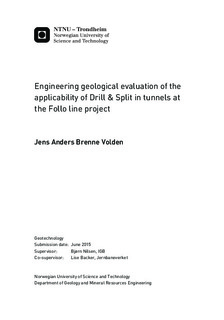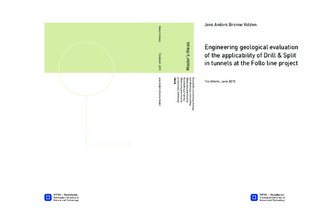| dc.description.abstract | As a part of major upgrading of regional railway lines around Oslo, The Follo line project comprises the construction of new twin-tube tunnels connecting Oslo central city to the new Ski mass transit station. Due to the tunnel alignments close proximity to existing underground structures, vibrations limits is set upon parts of the tunnel excavation work. Consequently, The Norwegian National Rail Administration has suggested mechanical excavation by Drill & Split as their preferred excavation method for subjected sections.
Q-values assessed by the author suggests that the rock mass quality ranges from 13-40, which is classified as good quality rock. Laboratory testing of intact rock enhances the impression of good quality rock, as it presents high compressive strength. The measurements undergone corresponds well with previous assessments, and are therefore assumed to reflect the rock masses for most part of the area subjected to Drill & Split reasonably well.
The main scope of this study is to analyze the applicability of D&S under the assessed geological situation in finite element code Phase2. This excavation method was modelled by applying staged loading that were ranging from 10-50 MPa inside the borehole at the tunnel face. When splitting against a free face, this was found to replicate the initial splitting process reasonably well. With this basic configuration set up, it was possible to model the influence of various aspects such as individual and accumulated rock parameter and assess different stress field situations by varying input parameters in Phase2. Their respective influence were evaluated in terms of easiness of yielding.
The results from this study suggests that lowering the GSI-parameter has the most impact upon easiness of splitting, while the elastic properties of the rock mass (ν and E-modulus) has no practical influence. The intact UCS has also a noticeable influence and Hoek-Brown parameter mi has a slight influence. In general terms, easiness of splitting is dependent of the overall rock quality in such a manner that stronger and more massive rock mass is considered harder to split. The stress analysis suggests that easiness of splitting may benefit greatly from altering the free face design according to the in-situ stress field in such a manner that the most anisotropic stress state is induced. This creates de-tensioned zones around the periphery of the free face that can be exploit for easier splitting at the tunnel face. Based on numerical analysis and assumptions, the author considers the method as the best choice available under the given conditions at the Follo line project. | |

